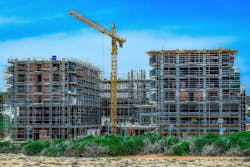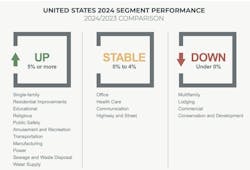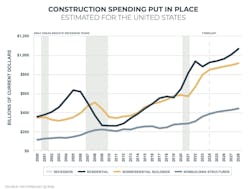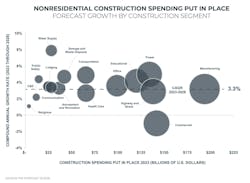Slower construction spending rate foreseen for next four years
After expanding by more than 40% since 2020, construction and engineering spending will continue to expand, but at a slower pace of between 2% and 3% through 2028, according to the consultant and investment banking firm FMI in its just-released industry overview.
This outlook provides growth projections for residential and commercial spending by sectors within those broader categories. The outlook also dives into the Canadian market with a growth evaluation for each province.
FMI assumes that the U.S. economy is headed for a recession sometime in 2025. And its outlook’s positive projections, especially about infrastructure construction, are supported by legislation, such as the Infrastructure Investment and Jobs Act, that might not survive the Trump Administration’s frantic cost cutting.
Multifamily housing, which was down 7% in construction spending last year, is projected to dip again—by 13% this year and 1% in 2026—before showing signs of life in the last two years of FMI’s forecast period. On the other hand, FMI expects single-family residential construction—which rose by 6% to $424 billion in 2024, and which FMI predicts will increase to $509 billion in 2028—to drive demand for other construction segments, like institutional and nonbuilding structures.
FMI also states that rapid advancements in AI and quantum computing will provide opportunities across the engineering and construction industries.
The industry’s slower rate of growth over the next four years “should provide many stakeholders with opportunities to reassess priorities and work to address many of the longer-term challenges the built environment faces,” wrote the outlook’s authors.
Four big trends to watch
Based on its panel of industry experts, FMI’s Nonresidential Construction Index for the first quarter of 2025 stood at 56.9, the highest it’s been since the third quarter in 2021. Any measure above 50, said FMI, indicates expansion. FMI foresees varying degrees of longer-range recovery in the lodging, office, commercial and warehouse sectors; the status quo for education and healthcare spending, some recession in amusement and recreation, and a downturn in manufacturing construction spending.
Data centers, a subset of the office sector in FMI’s outlook, saw spending balloon by 52% in 2024, and is expected to register double-digit spending increases in three of the next years of FMI’s forecast period, hitting $48 billion in 2028.
The increase in data centers, coupled with the reshoring of manufacturing facilities in general, is one of four trends to watch for the built environment this year and beyond, stated Chris Daum, FMI’s President and CEO. And with data centers accounting for an estimated 2% of the total electricity consumed in the U.S., “the rise in data centers is also changing how electricity is produced and how much it costs,” wrote Daum.
The second trend that Daum calls out pertains to how long-term efficiency and sustainability implications are reshaping how the world gets built. The global urbanization trend is expected to continue, with 89% of the U.S. population projected to be living in cities by 2050. The U.S. government is mandating that states develop resilience plans to qualify for federal funding, and has earmarked more than $50 billion to enhance climate adaptation and resilience across the country.
Trend No. 3 states companies that put their workers first are best-suited to solve key labor challenges. Nearly two-fifths of FMI’s panel of experts expects their companies to increase their hiring over the next few years. Companies with a clear pipeline for developing talent understand that employee empowerment helps to streamline their operations.
The fourth trend Daum identifies finds companies that leverage digital tools are boosting operational efficiency and profitability in construction. But technology, he wrote, is only part of the solution. “Companies need a clear business strategy aligned with a comprehensive data and technology roadmap” that “begins with understanding the ‘why’ behind technology investments.” Digital transformation “is a continuous, proactive journey.”
Syncing construction spending with industry transformation
FMI’s outlook anticipates an increase in mergers and acquisitions within the engineering and construction industry this year. It also expects private equity to play “a significant role” in M&A activities.
Key factors that are influencing M&A patterns, wrote FMI, include population growth and migration, deferred infrastructure investment, environmental impact and the costs of natural disasters, tech advances in AI and robotics, succession planning, sector fragmentation, labor shortages, energy demand, digitalization, and supply-chain resilience.
How companies position themselves to respond to these factors will determine how smoothly those companies enter and operate in this industry’s transformative era.




